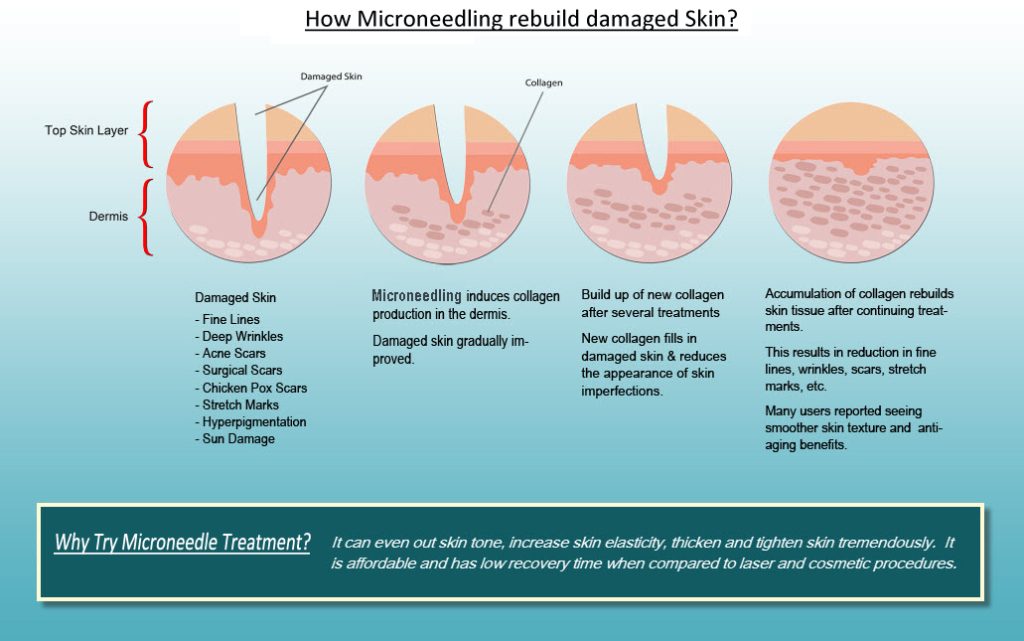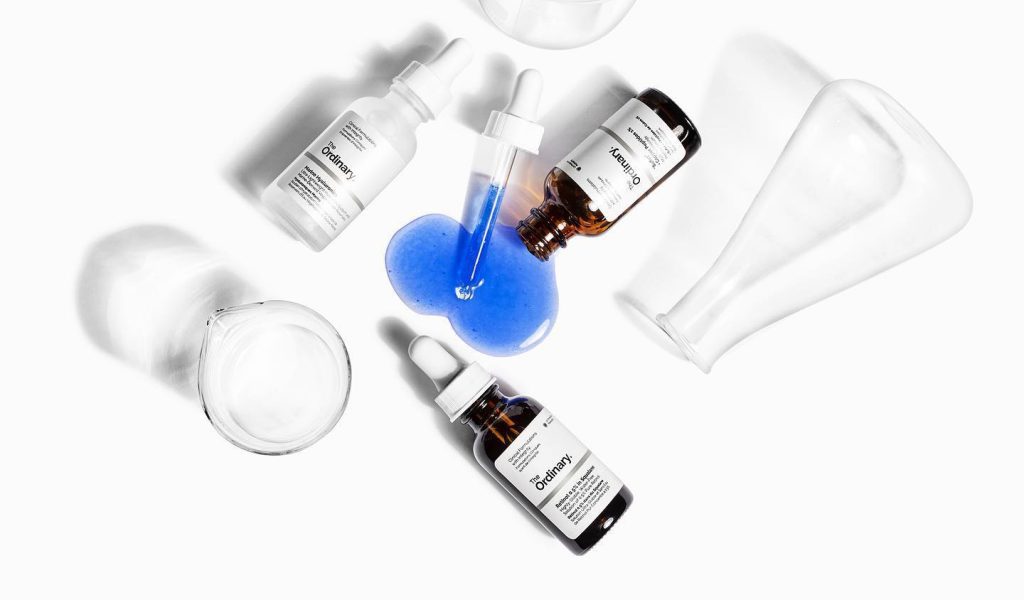Is your skin feeling lackluster and marked by fine lines, scars, or uneven texture? In a world full of skincare treatments, finding a truly effective solution can be overwhelming. Among the many options, few stand out like microneedling. This minimally invasive procedure taps into your skin’s natural healing abilities. It rejuvenates and restores without the harshness of chemicals or long recovery times.
As we age, our skin produces less collagen and elastin. These proteins are essential for keeping skin firm, smooth, and resilient. This decline can lead to sagging, wrinkles, and an overall tired appearance. Microneedling provides a proactive way to fight this aging process. By creating tiny, controlled injuries on the skin’s surface, it activates your body’s natural repair mechanisms. Essentially, microneedling encourages your skin to heal and renew itself. The result is a firmer, more youthful complexion.
In this comprehensive guide, we’ll explore the benefits of microneedling. We’ll also review the latest scientific research supporting its effectiveness. Plus, we’ll share expert tips to help you maximize your results. Whether your goal is to reduce acne scars, refine skin texture, or enhance your overall radiance, this article will give you the knowledge you need. Let’s begin your journey to vibrant, revitalized skin!
- What is Microneedling? The Science Behind the Technique
- The Science Behind Microneedling: Research and Evidence
- Common Treatment Areas
- Is Microneedling Right for You? Assessing Suitability
- the Results and Expectations
- Unlock Your Skin’s Potential!
- References
What is Microneedling? The Science Behind the Technique
Microneedling is a highly effective treatment based on advanced skin biology. It offers a promising approach to rejuvenation. At its core, microneedling uses fine needles to create micro-injuries in the skin’s outer layer. These tiny punctures, though barely visible, activate your body’s natural wound-healing process. In response, your body increases its production of collagen and elastin—two critical proteins that keep skin firm, smooth, and youthful. This process leads to noticeable improvements in skin texture, enhanced firmness, and a refined complexion.
During a microneedling session, a trained professional uses a specialized device with fine needles. They gently roll or stamp the device across the skin’s surface. As these controlled micro-injuries occur, they trigger your body’s repair mechanisms. This action results in the gradual production of new collagen and elastin. One of the added benefits is its ability to enhance the absorption of topical serums and treatments. The micro-channels created during the procedure allow active ingredients to penetrate deeper into the skin, maximizing their effectiveness. This combination of collagen production and improved serum absorption makes microneedling a versatile treatment. Whether your goal is to diminish fine lines, reduce acne scars, or boost overall skin radiance, microneedling can help.

The Science Behind Microneedling: Research and Evidence
Microneedling’s effectiveness is well-supported by scientific research. Numerous studies highlight its benefits for improving skin texture and reducing scars and wrinkles. For instance, a study published in the Journal of Cutaneous and Aesthetic Surgery demonstrated that microneedling significantly boosts collagen and elastin production, leading to firmer, more resilient skin.
Similarly, research in the Journal of Clinical and Aesthetic Dermatology focused on microneedling’s impact on atrophic acne scars. This study showed a notable reduction in scar severity after multiple sessions, with minimal side effects reported. These findings reinforce microneedling’s role as a powerful treatment for enhancing skin appearance and addressing specific concerns.
In my practice, I often combine microneedling with other treatments to effectively target individual skin issues. I’ll delve deeper into these combination treatments in a future article.
The Benefits of Microneedling: More Than Just Skin Deep
Microneedling offers a wide range of benefits, making it an effective solution for various skin concerns. Here are some of its key advantages:
Boosts Collagen Production
One primary reason people choose microneedling is its ability to stimulate collagen production. Collagen, a structural protein, is essential for maintaining skin’s strength and elasticity. As we age, collagen production decreases, leading to sagging skin and wrinkles. Microneedling reverses this process by encouraging new collagen growth. A study published in Plastic and Reconstructive Surgery (2008) found that microneedling significantly increases collagen and elastin levels. This improvement enhances skin texture, reduces wrinkles, and boosts firmness.
Improves Skin Texture and Tone
Microneedling effectively addresses skin issues such as acne scars, enlarged pores, and uneven tone. By promoting cell turnover and regeneration, it smooths rough patches and refines overall skin texture, resulting in a more even complexion.
Reduces Fine Lines and Wrinkles
By boosting collagen and elastin production, microneedling softens fine lines and wrinkles. The skin appears firmer, plumper, and more youthful.
Enhances Product Absorption
After microneedling, the skin becomes more permeable. This allows skincare products to penetrate deeper layers. Increased absorption maximizes the effectiveness of serums and treatments, enhancing your skincare routine’s results.
Minimizes Pore Size
Microneedling also reduces the appearance of large pores. By stimulating collagen production around the pores, it tightens the surrounding skin, creating a smoother and more refined surface.
Softens Scars
Microneedling promotes collagen production, helping to remodel scar tissue. Over time, scars become less rigid and more flexible, resulting in a smoother appearance. A study from Dermatologic Surgery (2021) demonstrated that microneedling significantly improves the texture and depth of atrophic acne scars after multiple sessions, proving its efficacy in scar reduction.
Microneedling not only enhances the skin’s natural healing processes but also delivers comprehensive benefits. From improving texture to reducing wrinkles and scars, it is a powerful, science-backed treatment that can make a significant difference in your skin’s overall appearance.
Common Treatment Areas
Microneedling is a versatile treatment that can target various areas of the body to address specific skin concerns. While it’s most commonly used on the face to smooth fine lines, wrinkles, acne scars, and hyperpigmentation, other areas can also benefit. Here’s how microneedling works its magic on different parts of the body:
Neck and Chest
These areas often show early signs of aging and sun damage. Microneedling improves skin texture and firmness by stimulating collagen production. It reduces fine lines and restores a smoother, more even tone.
Hands
Hands often receive little attention in skincare routines, even though they can show age just as much as the face. Microneedling enhances skin tone and diminishes age spots, giving hands a younger, more revitalized appearance.
Stretch Marks
Microneedling effectively treats stretch marks on the abdomen, thighs, and hips. By boosting collagen production, it promotes skin regeneration. This helps smooth out and reduce the visibility of stretch marks over time.
Back
For individuals with acne scars on their back, microneedling can help fade those scars. The treatment encourages the skin’s natural healing process by increasing collagen production. This gradually reduces the appearance of scars.
Scalp
Microneedling can even be used on the scalp to promote hair growth. It improves blood circulation and stimulates dormant hair follicles. This shows promise in treating hair thinning or loss.
The adaptability of microneedling makes it an effective treatment for improving skin health and appearance across multiple areas of the body.
Is Microneedling Right for You? Assessing Suitability
While microneedling offers significant benefits, it isn’t suitable for everyone. People with active skin infections, severe acne, or chronic skin conditions should consult a dermatologist to determine if this treatment is appropriate. Pregnant individuals or those with certain medical conditions may also need to avoid microneedling or seek medical advice before proceeding.
Microneedling is generally safe for all skin types, but those with sensitive or reactive skin should consult a licensed professional. This ensures that the treatment aligns with their specific skin concerns. Discussing your needs with an experienced provider will help you determine if microneedling is the most effective option for you.
People with conditions like active acne, eczema, or psoriasis may need to avoid the procedure or take specific precautions. If you’re on medications such as blood thinners, microneedling may increase the risk of bruising or bleeding. Consulting a licensed medical aesthetic provider is essential before undergoing any cosmetic procedure.
To reduce the risk of complications, limit sun exposure before your microneedling session. If you frequently spend long periods in the sun, this treatment might not be the best choice for you. After the procedure, your skin becomes more sensitive to UV rays. Therefore, using a broad-spectrum sunscreen with at least SPF 30 is crucial.
By considering these factors and consulting a qualified professional, you can ensure that microneedling is both safe and effective in helping you achieve your skincare goals. Expert advice will guide you toward an informed and personalized decision.
Preparing for the treatment: Setting the Stage for Success
Understanding the microneedling process is crucial for easing any concerns and ensuring you’re fully prepared. Proper preparation and clear expectations will help you maximize the benefits and achieve the glowing skin you desire.
Pre-Treatment Consultation
Before your microneedling session, you will meet with a licensed medical aesthetic professional. During this consultation, you’ll discuss your skin goals and review your medical history. This meeting is vital for customizing the treatment to your needs. Share your skin concerns and medical background openly. This information allows the provider to assess your skin type, condition, and overall suitability for microneedling. Based on this evaluation, they will create a personalized treatment plan specifically for you. Be sure to follow any pre-treatment instructions, such as avoiding sun exposure or certain skincare products, to ensure the best outcome.
Pre-Treatment Guidelines
Open communication with your provider is essential. Inform them of any medical conditions and any medications or supplements you’re taking to prevent interference with the procedure.
Timing: Schedule your appointment at least two weeks before any important event. Redness, swelling, or peeling may occur as your skin heals, and these effects can take a few days to subside.
Medications and Supplements: Some medications and supplements can affect how your skin reacts to microneedling. Your provider may recommend stopping Aspirin, NSAIDs, and supplements like Ginkgo Biloba, garlic, ginseng, flax oil, cod liver oil, and vitamins A and E about a week before treatment. This can reduce the risk of bruising or bleeding. Always consult your primary physician before discontinuing prescribed medications.
Cold Sores: If you have a history of cold sores, notify your provider. You may need antiviral medication to prevent an outbreak.
Skin Procedures: Avoid intense pulsed light (IPL), broadband light (BBL), laser treatments, and waxing for at least seven days before your microneedling session.
Skincare Products: Discontinue the use of topical retinoids three to five days prior to treatment to minimize skin sensitivity.
Diet and Lifestyle: In the 24 to 48 hours before your session, avoid alcohol, caffeine, niacin supplements, high-sodium and high-sugar foods, refined carbs, spicy foods, and smoking. These can increase the likelihood of bruising or swelling.
Following these guidelines will help ensure a smoother, more effective microneedling experience, setting you up for optimal results.
What to Expect During a Microneedling Session
Knowing what to expect during your treatment session can make the experience more comfortable and less daunting.
Preparation
Your treatment will start with a thorough cleansing of your skin. To minimize discomfort, a numbing cream will be applied. This allows you to relax throughout the procedure.
Needle Depth
The provider will adjust the depth of the needles based on your specific skin concerns and the area being treated. For superficial issues like fine lines and pigmentation, they typically use needles ranging from 0.5mm to 1.0mm. For deeper concerns, such as acne scars or stretch marks, they generally apply depths of 1.5mm to 2.0mm.
Procedure
The microneedling device will move gently across the treatment area, creating controlled micro-injuries in your skin. This process may cause mild discomfort, but most patients find it quite tolerable. Many describe the sensation as a slight prickling or scratching.
Duration
A standard session usually lasts between 30 and 60 minutes, depending on the size of the area being treated and your specific needs.
Microneedling Post-treatment skin care routine
Effective post-treatment care is crucial for promoting healing and minimizing side effects after microneedling. After your procedure, your skin may appear red and slightly swollen, resembling a mild sunburn. This reaction is normal and should diminish within a few days. Following these post-treatment care instructions will help you achieve the best results:
Redness and Sensitivity:
You can expect some redness or sensitivity, which may last up to a few days.
Peeling
Peeling may begin 3 to 5 days after the procedure as your skin starts to renew itself.
Avoid Touching
Refrain from touching or scratching the treated area to prevent infection or irritation.
Limit Physical Activity
Avoid strenuous exercise or activities that cause sweating for 24 hours, as the micro-channels in your skin become more susceptible to bacteria.
Sun Protection
Steer clear of tanning and extended sun exposure. If you need to be outdoors, apply a broad-spectrum sunscreen with at least SPF 30, reapplying it every 2 hours.
Gentle Cleansing
Use a mild, non-irritating cleanser to wash your face. Avoid exfoliating or abrasive products for at least a week to prevent further irritation.
Hydration
Apply a soothing, hydrating serum or moisturizer to keep your skin nourished and support the healing process. Products containing hyaluronic acid are particularly effective.
By adhering to these guidelines, you will support a smooth recovery and maximize the benefits of your microneedling treatment.

the Results and Expectations
Microneedling has gained popularity as an effective procedure for improving skin texture and overall appearance. To maximize the benefits of this treatment, it’s essential to understand the expected results, the timeline for seeing them, and the factors that can influence outcomes. Here’s what you need to know:
Timeline for Visible Results
Microneedling triggers a gradual process of skin healing and regeneration. Here’s how the results typically unfold:
Immediate Post-Treatment: After the procedure, your skin may appear red and swollen, resembling a mild sunburn. This reaction is normal and usually subsides within a few days as your skin begins to heal.
Initial Improvement: Within 2 to 4 weeks, you may start to notice early signs of improvement, such as smoother skin texture and a reduction in fine lines. These changes occur as collagen production and your skin’s natural repair processes kick in.
Optimal Results: Full results generally become evident 3 to 6 months after the treatment. During this period, ongoing collagen and elastin production further refines and rejuvenates your skin. Research shows that collagen remodeling and skin enhancements can continue for several months, leading to long-lasting effects.
Understanding this timeline will help you set realistic expectations and appreciate the gradual transformation of your skin.
Treatment Frequency and Timing
The effectiveness of microneedling partly hinges on the frequency of treatments. For most individuals, professionals recommend sessions every 4 to 6 weeks. This schedule gives your skin ample time to heal and regenerate between treatments. If you have more significant concerns, such as deep scars or extensive damage, you might need more frequent sessions initially. Your skincare professional will create a customized treatment plan tailored to your specific needs and how your skin responds.
By understanding these aspects of microneedling, I hope you can set realistic expectations and make informed decisions about your skincare treatments.
FAQs About Microneedling
Here are answers to some common questions about microneedling:
Q: Can microneedling be used on all skin types?
A: Yes, microneedling suits all skin colors and types.
Q: How long does a microneedling session take?
A: Each session typically lasts between 30 and 60 minutes, depending on the area being treated and individual needs.
Q: How many sessions are needed for optimal results?
A: Most patients achieve the best results with 3 to 4 sessions spaced 4 to 6 weeks apart. The exact number of sessions may vary based on your skin condition and personal goals.
Q: What is the recovery time?
A: Recovery is usually quick. Patients often experience redness and mild swelling, which typically subsides within a few days. Full recovery and the appearance of final results may take several weeks.
Q: Do I need to use specific products after microneedling?
A: It’s recommended to use the post-procedure skincare products provided, designed to soothe and support healing with ingredients like vitamins and anti-inflammatory agents.
Q: Are there any side effects?
A: Common side effects include temporary redness, swelling, and slight discomfort. Serious side effects are rare but may include infection or prolonged irritation.
Q: Can microneedling be combined with other treatments?
A: Yes, you can combine microneedling with other treatments, such as chemical peels or laser therapy, to enhance results. However, discuss any combination treatments with your provider.
Unlock Your Skin’s Potential!
Ready to unlock your skin’s full potential? Dive deeper into the transformative world of medical aesthetics and discover how it can elevate your skincare routine. Join our community for expert insights, exclusive tips, and the latest in skincare innovations. Your journey to radiant, youthful skin starts here—subscribe now and stay informed!
References
- Fabbrocini, G., Annunziata, M. C., D’Arco, V., De Vita, V., Pastore, F., Monfrecola, G. (2009). “Microneedling: An Update.” Journal of Cutaneous and Aesthetic Surgery, 2(2), 110-113.
- Majid, I. (2009). “Microneedling Treatment of Acne Scars in Asian Skin Type.” Journal of Clinical and Aesthetic Dermatology, 2(2), 24-27.
- Aust, M. C., Reimers, K., Kaplan, H. M., Stahl, F., Repenning, C., Gohritz, A., & Vogt, P. M. (2008). Percutaneous collagen induction: An alternative treatment for scars, wrinkles, and skin laxity. Plastic and Reconstructive Surgery, 121(4), 1421-1429.
- Rossi, A., & Fortuna, M. C. (2017). Microneedling in Androgenetic Alopecia: Preliminary Observations. International Journal of Trichology, 9(3), 116-119. https://doi.org/10.4103/ijt.ijt_104_16
- Singh, A., & Yadav, S. (2016). Microneedling: Advances and widening horizons. Indian Dermatology Online Journal, 7(4), 244-254. https://pubmed.ncbi.nlm.nih.gov/27559496/
- Fabbrocini, G., Vita, V. D., Sparavigna, A., Gurioli, C., Monfrecola, G., & Colucci, R. (2021). A randomized controlled trial on the efficacy of microneedling in the treatment of atrophic acne scars. Dermatologic Surgery, 47(3), 359-366.


Leave a Reply